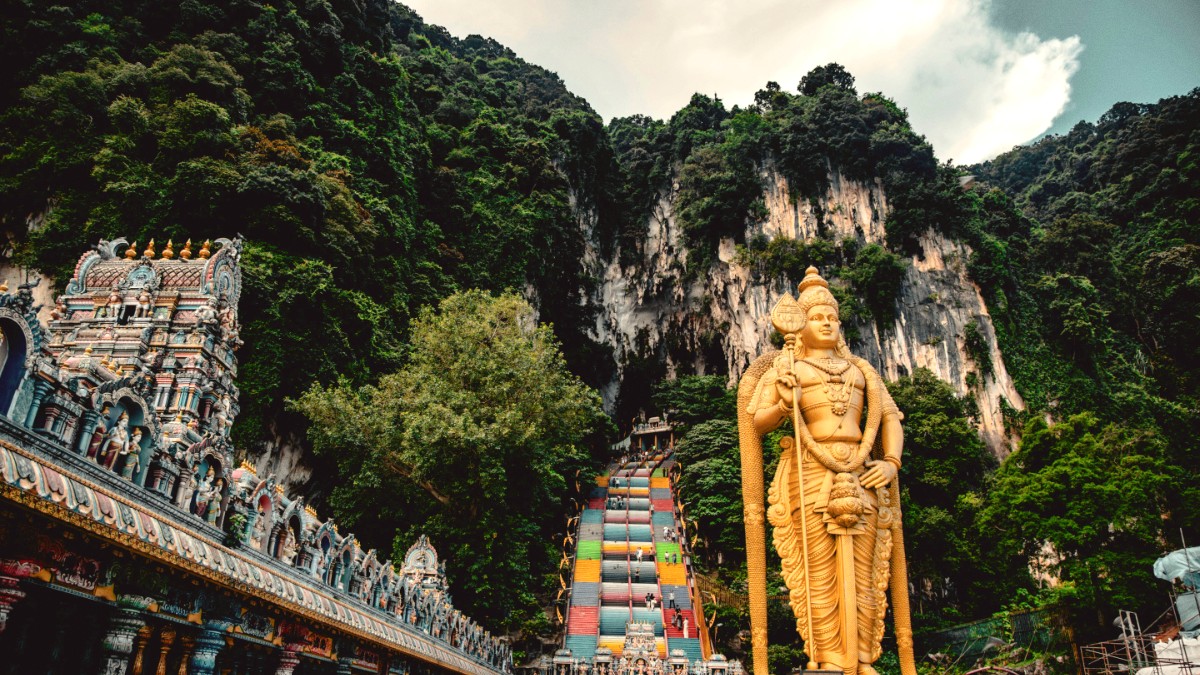
Malaysia
Batu Caves sits approximately 13 kilometers (8 miles) north of Kuala Lumpur's city center, within the state of Selangor. Its formation began from millions of years of geological processes, shaping the impressive limestone hills that dominate the landscape. These hills feature a series of caves and cave formations, carved out by natural erosion and water flow over millennia. The main caves, including the Temple Cave (or Cathedral Cave), Ramayana Cave, and Dark Cave, nestle within these karsts, forming a natural sanctuary. The surrounding area remains relatively urbanized, forming part of the greater Kuala Lumpur metropolitan region. Despite its proximity to a bustling city, the caves retain an aura of untouched nature, a green escape from concrete surroundings.
The site is not simply a singular cave; it is a complex of interconnected caverns and smaller grottoes within the limestone outcrop. The dominant feature is the main cave, which opens up dramatically after the ascent of the famously colorful steps. The natural setting creates an unique microclimate, slightly cooler within the caves themselves but consistently humid year-round, reflecting Malaysia's tropical environment.
This geographical placement makes Batu Caves easily accessible from Kuala Lumpur, making it a popular day trip for both locals and international visitors. Its location within a geological marvel provides a setting that feels both ancient and alive, with the limestone formations themselves narrating a story of the Earth's long history.
The history of Batu Caves dates back to the late 19th century, when it gained recognition as a place of worship for the Hindu community in Malaysia. K. Thamboosamy Pillai, an Indian trader, played a pivotal role in establishing the temple. He drew inspiration from the Vel (spear) shape of the main cave's entrance and dedicated the temple to Lord Murugan, a Hindu deity. Since its dedication, Batu Caves has become one of the most important Hindu pilgrimage sites outside of India.
The construction of the various temples and shrines within and around the caves happened gradually over decades, largely funded by donations from devotees. The iconic 42.7-meter (140 ft) statue of Lord Murugan, completed in 2006, further solidified the site's status as a symbol of Hindu faith and an unmissable landmark. Each year, during the Hindu festival of Thaipusam, Batu Caves becomes the focal point for hundreds of thousands of devotees who undertake a pilgrimage, carrying Kavadis and Paal kudams (milk pots) as acts of penance and devotion. This festival showcases the depth of religious fervor and the cultural richness that defines the site.
Recognition as a Hindu worship site.
K. Thamboosamy Pillai dedicates the temple to Lord Murugan.
Initial construction of temples and shrines within the caves.
Completion of the Lord Murugan statue, 42.7m tall.
Thaipusam festival draws hundreds of thousands of pilgrims.
Beyond its religious significance, Batu Caves also possesses historical standing as a natural landmark. Its caves have been studied for their geological formations and unique ecosystems, notably the Dark Cave, which houses diverse and rare fauna. The site's transformation from a natural wonder to a revered spiritual center showcases the blend of nature, culture, and faith that characterizes Malaysia.
The impressive limestone formations tell a story of the Earth's long history, making the caves a subject of geological study and natural appreciation.
The Dark Cave, in particular, is a natural habitat for unique cave-dwelling animals, contributing to the site's ecological value and drawing researchers.
Visitors witness not only a beautiful natural landscape but also centuries of human devotion and community building. The ongoing maintenance and expansion of the temple complex reflect a living history, continuously shaped by its worshippers and visitors.
Batu Caves present an experience for every traveler. The journey begins at the base, where a colossal, gold-painted statue of Lord Murugan stands guard, inviting onlookers to begin the ascent. Immediately behind the statue, a daunting flight of 272 colorful steps rises steeply, leading directly into the cavernous main temple, known as Cathedral Cave.
This particular cave, vast and open to the sky at one end, houses several Hindu shrines, forming a serene atmosphere despite the constant flow of visitors. The site is more than just a collection of caves and statues; it is a cultural and spiritual hub. It displays insight into the Hindu faith and its expression in Malaysia. Visitors observe daily rituals, listen to rhythmic chants, and witness the profound devotion of pilgrims. Batu Caves mark a blend of nature, culture, and religion, presenting an unique snapshot of Malaysia's identity.
The main Cathedral Cave hosts various Hindu shrines, offering a peaceful atmosphere for contemplation amidst visitors.
The Dark Cave provides guided tours into a pristine section, demonstrating unique rock formations and rare cave-dwelling animals.
Art Gallery Cave and Museum Cave display Hindu statues and murals, offering further cultural immersion.
The entire complex bustles with activity, from vendors selling religious offerings and snacks to the ever-present population of curious macaques, a constant source of amusement and a reminder to keep belongings secure.